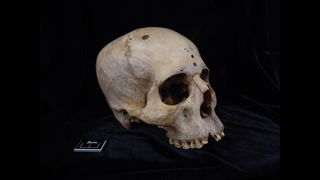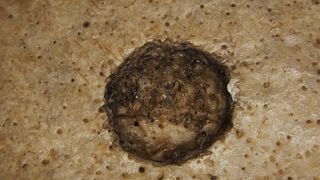
A new analysis of lesions found on ancient Egyptian skulls suggests that humans were attempting to surgically treat cancer more than 1,000 years earlier than once thought. One of the skulls, which belonged to a man who lived between 2686 and 2345 B.C., is pictured above.
(Image credit: Tondini, Isidro, Camarós, 2024)
Ancient Egyptians tried to surgically treat cancer more than 4,000 years ago, researchers have discovered.
In a new study, researchers analyzed a human skull from the University of Cambridge’s Duckworth Collection dating to between 2686 and 2345 B.C. The skull contained evidence of a large primary tumor, as well as more than 30 smaller, metastatic lesions. The researchers discovered that these lesions were surrounded by cut marks, possibly made using a sharp object such as a metal instrument. This suggests that ancient Egyptians attempted to conduct surgery to treat the patient, who is believed to have been a man in his early 30s, the researchers said.
Until now, the oldest-known description of cancer came from around 1600 B.C. Edwin Smith Papyrus from Egypt, which is thought to be a copy of a work from centuries earlier. The text chronicled several breast tumors but underlined that there was “no treatment” for them.
The new findings, which were published Wednesday (May 29) in the journal Frontiers in Medicine, may subsequently shift our conception of when modern medicine began, the authors said.
Related: Rare tumor with teeth discovered in Egyptian burial from 3,000 years ago
“What we found is the first evidence of a surgical intervention directly related to cancer,” study co-author Edgard Camarós Perez, a paleopathologist at the University of Santiago de Compostela in Spain, told Live Science. “This is where modern medicine starts.”
The team also analyzed a skull from a woman who was 50 years old when she died and lived between 664 and 343 B.C., whose skull is also housed at the University of Cambridge’s Duckworth Collection. Like the man, she had a big lesion on her skull that was suggestive of cancer. However, she had two additional lesions on her skull that were caused by traumatic injuries, such as an attack using a sharp weapon, the team found.
Get the world’s most fascinating discoveries delivered straight to your inbox.

Close-up of the tumors found on the skull of the man in his early 30s. Cut marks can be seen on several of them. (Image credit: Tondini, Isidro, Camarós, 2024)
Both of the traumatic lesions had healed, hinting that medicine in ancient Egypt was advanced enough to treat her trauma — but not her cancer.
The new findings suggest that cancer was a “frontier” in ancient Egyptians’ medical knowledge — something they may have tried but failed to treat successfully, Camarós Perez said. However, he acknowledged that without the patients’ clinical history, scientists can’t paint the full picture of the cancer that they experienced.
Going forward, the team wishes to look even further back in time to learn more about how humans have dealt with cancer over millennia.
“If we know that more than 4,000 years ago, ancient Egyptians were trying to understand cancer at a surgical level, we are absolutely convinced that this is just the beginning of something that started many, many thousands of years ago,” Camarós Perez said.
Emily is a health news writer based in London, United Kingdom. She holds a bachelor’s degree in biology from Durham University and a master’s degree in clinical and therapeutic neuroscience from Oxford University. She has worked in science communication, medical writing and as a local news reporter while undertaking journalism training. In 2018, she was named one of MHP Communications’ 30 journalists to watch under 30. ([email protected])
>>> Read full article>>>
Copyright for syndicated content belongs to the linked Source : Live Science – https://www.livescience.com/archaeology/ancient-egyptians/ancient-egyptians-tried-to-treat-cancer-4000-years-ago-cut-marked-skull-indicates






























